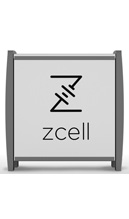Flow Batteries

The term “flow battery” describes a number of similar technologies that all fall under the same umbrella. I’ll predominantly discuss ‘ZCell’ zinc-bromide batteries here, which were manufactured by Australian company RedFlow – but at the time of updating this page the ZCell is no longer available.
Discussing the science behind flow batteries can get rather technical, so I’ll massively simplify it. A flow battery is mostly made up of a water based solution (zinc bromide in this case) that flows between two tanks. When the battery charges the zinc is extracted from the liquid and stored separately. When discharging, the zinc is put back into the liquid. The zinc ‘flows’ from a big plastic tank at the bottom to the electrodes at the top. Hence the name.
One of the core advantages that flow batteries have over lithium-ion and lead-acid batteries is that they have a 100% depth-of-discharge. This means the battery can be entirely discharged in a cycle with no negative effects on the lifespan of the battery. For comparison, lead-acid batteries have a 60% depth-of-discharge, and most lithium-ion batteries have an 80-90% depth-of-discharge.
Flow batteries can also sit on the shelf forever-and-a-day at zero charge without degrading. Again – most other battery technologies need to be kept at a minimum charge level.
There are a number of other benefits that flow batteries offer:
- They can tolerate extreme weather conditions, up to 50 degrees Celsius.
- The zinc-bromine liquid inside the flow batteries is a natural fire retardant.
- There is no chance of a thermal runaway (explosion!) due to the physical separation of the different battery components.
- Flow batteries are cheaper to refurbish due to their simple modular construction. For example, you can restore a ‘dead’ battery by simply swapping the electrode – for half of the original price of the battery.
A disadvantage of flow batteries is their life cycle compared to some higher-end lithium-ion batteries – they have a lifespan of approximately 4000 cycles at 100% depth-of-discharge, which is less than top quality lithium-ion’s 5000-6000 cycles at 80% depth-of-discharge.
They also need to regularly be 100% discharged to ‘clean’ the electrodes. However, the battery management system can be programmed to automatically do this regularly.
How much do flow batteries cost?
The Redflow ZCell (a 10kWh battery) cost around $12,600 AUD when it was available. This was around 20% more than similarly-sized lithium-ion battery systems at the time.
The advantages of flow batteries means they might start to seriously compete with lithium-ion batteries to become the de facto battery storage technology in the future. But first, flow battery manufacturers need to get costs down to a level that’s more reasonable for mass-market adoption, and iron out some challenges in manufacturing them consistently.